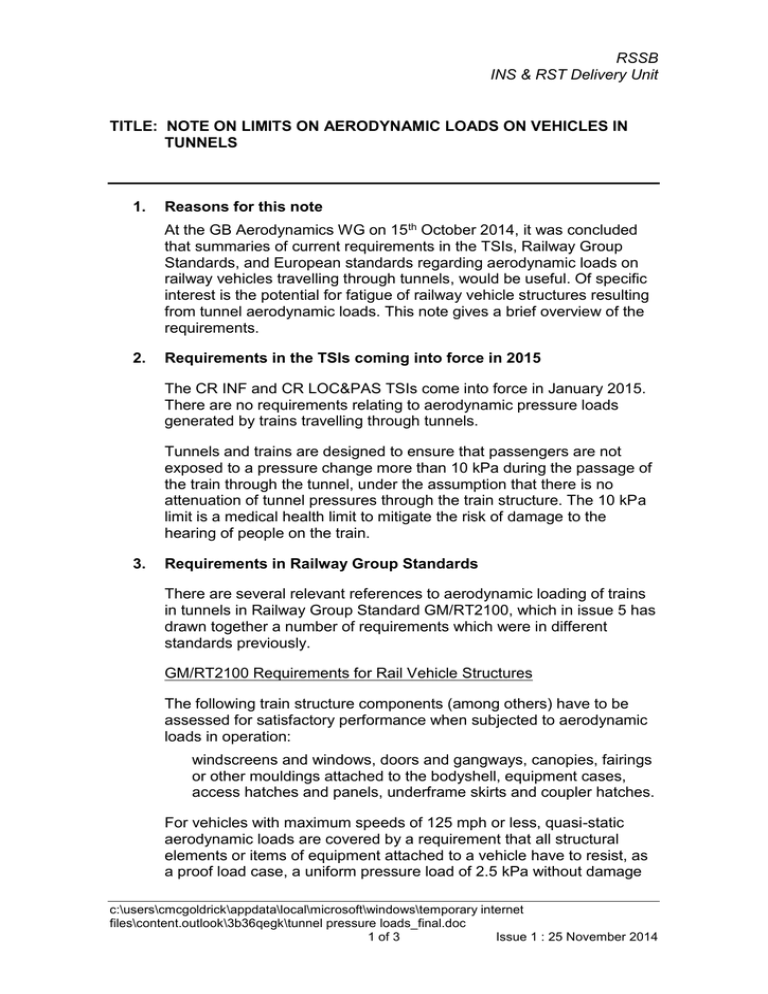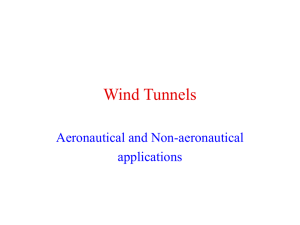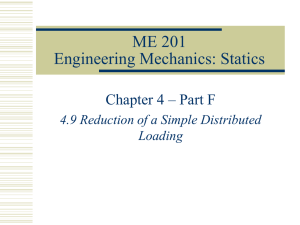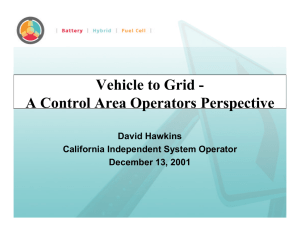RSSB INS & RST Delivery Unit
advertisement

RSSB INS & RST Delivery Unit TITLE: NOTE ON LIMITS ON AERODYNAMIC LOADS ON VEHICLES IN TUNNELS 1. Reasons for this note At the GB Aerodynamics WG on 15th October 2014, it was concluded that summaries of current requirements in the TSIs, Railway Group Standards, and European standards regarding aerodynamic loads on railway vehicles travelling through tunnels, would be useful. Of specific interest is the potential for fatigue of railway vehicle structures resulting from tunnel aerodynamic loads. This note gives a brief overview of the requirements. 2. Requirements in the TSIs coming into force in 2015 The CR INF and CR LOC&PAS TSIs come into force in January 2015. There are no requirements relating to aerodynamic pressure loads generated by trains travelling through tunnels. Tunnels and trains are designed to ensure that passengers are not exposed to a pressure change more than 10 kPa during the passage of the train through the tunnel, under the assumption that there is no attenuation of tunnel pressures through the train structure. The 10 kPa limit is a medical health limit to mitigate the risk of damage to the hearing of people on the train. 3. Requirements in Railway Group Standards There are several relevant references to aerodynamic loading of trains in tunnels in Railway Group Standard GM/RT2100, which in issue 5 has drawn together a number of requirements which were in different standards previously. GM/RT2100 Requirements for Rail Vehicle Structures The following train structure components (among others) have to be assessed for satisfactory performance when subjected to aerodynamic loads in operation: windscreens and windows, doors and gangways, canopies, fairings or other mouldings attached to the bodyshell, equipment cases, access hatches and panels, underframe skirts and coupler hatches. For vehicles with maximum speeds of 125 mph or less, quasi-static aerodynamic loads are covered by a requirement that all structural elements or items of equipment attached to a vehicle have to resist, as a proof load case, a uniform pressure load of 2.5 kPa without damage c:\users\cmcgoldrick\appdata\local\microsoft\windows\temporary internet files\content.outlook\3b36qegk\tunnel pressure loads_final.doc 1 of 3 Issue 1 : 25 November 2014 RSSB INS & RST Delivery Unit or significant permanent deformation. This load is considered to act independently on either external or internal surfaces. For vehicles designed to operate at speeds over 125 mph, or where the vehicles are pressure sealed, an assessment of applicable quasi-static aerodynamic pressure loads has to be undertaken and an equivalent quasi-static pressure load derived. No methods to do this are provided. The capability to withstand the quasi-static aerodynamic loads can be demonstrated by testing, calculation, comparison with other vehicles, or by a combination of these. For transient aerodynamic pressure loads, there are also requirements for vehicles with maximum speeds below 125 mph and for trains designed for higher speeds. For the former vehicles the capability to withstand the maximum pressure loads, including the transient pressure loads, caused by a train entering, passing through and exiting tunnels, has to be demonstrated by testing, calculation, comparison with other vehicles, or by a combination of these. When determining transient pressure loads for vehicles with a maximum speed in excess of 125 mph, any assessment has to include, but is not limited to, the aerodynamic effects due to: a) Train and formation length. b) Train cross-section. c) Leading and trailing end shape. d) Tunnel cross section, including effects due to portal geometry on entry and exit. e) Tunnel length. f) Ventilation shafts or cross-passages. g) Single and double track tunnels. h) Other train types likely to be encountered. i) Relative entry times of trains entering a tunnel. j) Operational speeds. When determining the magnitude of transient loads, the degree of pressure sealing of the vehicle has to be taken into account. For vehicles with a maximum speed over 125 mph the effect of aerodynamic transient pressure loads has to be included in the fatigue life assessment of the vehicle and its components. Any operational limitations or restrictions to limit aerodynamic transient pressure loads c:\users\cmcgoldrick\appdata\local\microsoft\windows\temporary internet files\content.outlook\3b36qegk\tunnel pressure loads_final.doc 2 of 3 Issue 1 : 25 November 2014 RSSB INS & RST Delivery Unit caused by these vehicles when operating alongside existing lower speed rolling stock have to be identified. 4. Requirements in European standards There are only two relevant standards with relevant requirements, as follows. BS EN 12663-1:2010 Railway applications - Structural requirements of railway vehicle bodies - Part 1: Locomotives and passenger rolling stack This standard only contains general requirements as follows: “6.6.5 Aerodynamic loading Significant aerodynamic loads arise in the following circumstances: a) trains passing at high speed; b) tunnel operations; c) exposure to high cross winds. The relevance of such loads shall be considered and a suitable representation of the effects for analysis purposes shall be developed if necessary.” BS EN 14067-5:2006+A1:2010 Railway applications - Aerodynamics Part 5: Requirements and test procedures for aerodynamics in tunnels In Section 5 and 6 of this standard, general descriptions are given of how pressure loads are generated across the structures of unsealed and sealed railway vehicles. Train lifetime estimates of tunnel crossings are proposed. Also described are the way in which different amplitude pressure loadings can be calculated for a given pressure time history for a particular tunnel crossing scenario. In general, the information provided is descriptive. Revision of EN14067-5 This standard is under revision and Sections 5 and 6 will be rewritten to include the methods determined from the AeroTRAIN Project. The details of how these will be incorporated into the standard are not yet clear. However, during the AeroTRAIN Project, a software tool was developed which analyses a set of tunnels on a route and forms pressure load collectives for trains using the route. It is likely that some sort of load collective will be determined for a ‘typical’ European railway route, which can then be used to characterise the potential fatigue loads which should be sustained during the lifetime of a train. c:\users\cmcgoldrick\appdata\local\microsoft\windows\temporary internet files\content.outlook\3b36qegk\tunnel pressure loads_final.doc 3 of 3 Issue 1 : 25 November 2014 RSSB INS & RST Delivery Unit c:\users\cmcgoldrick\appdata\local\microsoft\windows\temporary internet files\content.outlook\3b36qegk\tunnel pressure loads_final.doc 4 of 4 Issue 1 : 25 November 2014



